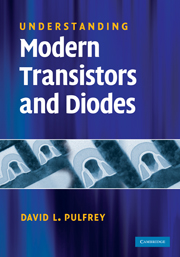Book contents
- Frontmatter
- Contents
- Preface
- 1 Introduction
- 2 Energy band basics
- 3 Electron and hole concentrations
- 4 Thermal equilibrium
- 5 Charge transport
- 6 np- and Np-junction basics
- 7 Solar cells
- 8 Light-emitting diodes
- 9 HBT basics
- 10 MOSFET basics
- 11 HJFET basics
- 12 Transistor capacitances
- 13 Transistors for high-speed logic
- 14 Transistors for high frequencies
- 15 Transistors for memories
- 16 Transistors for high power
- 17 Transistors for low noise
- 18 Transistors for the future
- Appendices
- Index
1 - Introduction
Published online by Cambridge University Press: 05 June 2012
- Frontmatter
- Contents
- Preface
- 1 Introduction
- 2 Energy band basics
- 3 Electron and hole concentrations
- 4 Thermal equilibrium
- 5 Charge transport
- 6 np- and Np-junction basics
- 7 Solar cells
- 8 Light-emitting diodes
- 9 HBT basics
- 10 MOSFET basics
- 11 HJFET basics
- 12 Transistor capacitances
- 13 Transistors for high-speed logic
- 14 Transistors for high frequencies
- 15 Transistors for memories
- 16 Transistors for high power
- 17 Transistors for low noise
- 18 Transistors for the future
- Appendices
- Index
Summary
It is highly probable that you will use a laptop computer when doing the exercises in this book. If so, you may be interested to know that the central processing unit of your computer resides in a thin sliver of silicon, about 1 square centimetre in area. This small chip contains over 100,000,000 Si MOSFETs, each about a thousand times smaller than the diameter of a human hair! The slender computer that you nonchalantly stuff into your backpack has more computing power than the vacuum-tube computers that occupied an entire room when I was a student over 40 years ago.
When you are reading this book, you may be distracted by an incoming call on your cell 'phone. That may get you wondering what's inside your sleek ‘mobile’. If you opened it up, and knew where to look, you'd find some GaAs HBTs. These transistors can operate at the high frequencies required for local-area-network telecommunications, and they can deliver the power necessary for the transmission of signals.
Of course, a cell 'phone nowadays is no longer just a replacement for those clunking, tethered, hand-sets of not so long ago: it is also a camera and a juke box. The immense storage requirements of these applications are met by Flash memory, comprising more millions of Si MOSFETs.
- Type
- Chapter
- Information
- Understanding Modern Transistors and Diodes , pp. 1 - 2Publisher: Cambridge University PressPrint publication year: 2010



